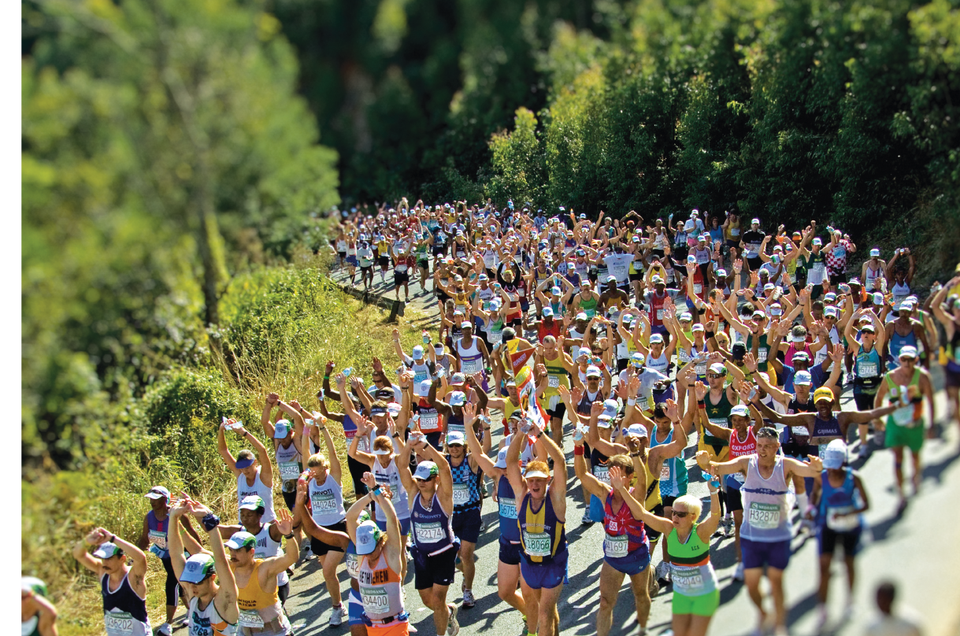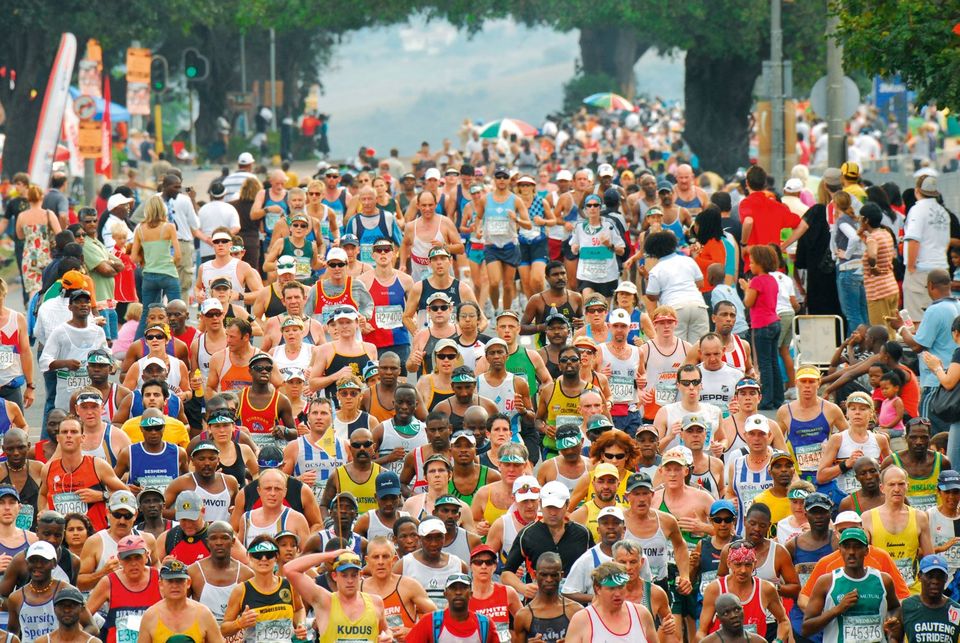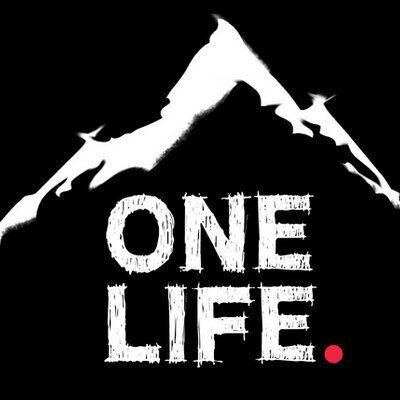The Comrades Marathon
Ian Corless runs a website
that is designed to help improve your running performance. The following is a really detailed account of Ian’s experience of The Comrades Marathon. It’s essential reading for anyone planning competing next year
Who are you
Ian Corless
The Challenge
The Comrades Marathon
How long did it take
8hrs 39mins 41 secs
What was the distance
89km (56miles)
How much did it cost
180 Euros for race entry only
Who was the organizer
http://www.comrades.com

What was it like
With the gunshot we moved forward with a cheer. It was 5:30am and still dark. What lay ahead was unknown to me. The only thing I was sure of was that the course was approximately 54 miles, we would finish in ‘PM’ at an altitude of 650m and that I would encounter ‘The Big Five’ en route. By the ‘Big Five’ I mean hills and not animals.
If you look at the course profile, the UP run is basically UP from start to finish with the first 30k without rest. I decided to forget pace targets and run on feel. Get to approximately 18 miles and then see how I feel.
I was amazed in the first 5k how many runners from groups B, C, D, E and F came running past me. Was I being over cautious or did they all know something I didn’t. I stuck my ground and run comfortable.
Running up the Berea Road to the summit at Tollgate it soon became apparent that this was no ordinary course. A brief decent doesn’t give any rest because you have been climbing for so long, in fact, the quads take a battering and then we start to head UP once again to the first of the Big Five – Cowies Hill.
Cowies is about 14k from the start and feeling fresh I maintained my effort level just easing off the pace a little for the increased incline. Here I meet a friend from the UK, David Ross. We have a chat and he kindly invites me to his Sisters for a Comrades Champagne Breakfast the following day. Sounded perfect! This early on in the race I didn’t find Cowies too hard. It is considered moderately difficult. Around me many started to walk. I heard one guy saying aloud “1 minute walk and then start running again for 9 min and repeat, come on, stick to the plan”. I looked at him – Green Number (means he had run 10 or more Comrades). I take a note and think to myself that this guy is on a strategy that he knows works. It’s a wise move. Stick to a plan early on and pay the dividends at the end! I honestly feel that Cowies needs to be respected purely from the point of view that by the team you reach it you have been running UP constantly from the start.
Down Cowies and I let myself go a little and relax into the downhill. I was cautious not to nail the down hills as this would obviously only impact on the legs and in particular the quads later on. I had purposely changed my running shoes some two months before Comrades to a new brand of shoe called Hoka One One. These shoes designed in France have been a revolution to my running. They may not be the best looking shoes on the market but the technology and the feel while running has proven to be a real plus for me. On the ‘downs’ the Hokas helped reduce the impact and provide a secure and stable foot bed from which to push on from.
At this point in the race my Camelback was irritating me. Why? Well in all previous runs over the 4- 6months leading to Comrades I had been wearing either long sleeve tops or short sleeve tops. At Comrades I wore a vest and of course the lack of fabric under the arm left the skin exposed and allowed the shoulder strap to rub. Fortunately the superb feed stations on the course had regular ‘Vaseline’ points so I made use of them to reduce the problem.
At 22k Fields Hill made it’s presence known. It rises 213m over 3km and it is a warning before Botha’s Hill.
I was still feeling pretty god here. I stuck to ‘feel’ and took the hill within my stride taking short steps and keeping my breathing easy. It would be nice to say that after Fields Hill you get some rest but unfortunately not. This is what makes Comrades so tough. You literally seem to get no flat…. You are either going up or down. Hillcrest arrives and you then have another decent. Botha’s Hill was shorter at around 2.5k long but by the time you reach the top you are nearing the half waypoint and the course is beginning to take its toll.
Another issue was my gels! After 30k I was sick of them. I don’t know why, maybe I was under more stress on the course than I thought or maybe it was the temperatures slowly increasing. Either way, my ‘self sufficient’ plan was proving pointless as I started to take water from the feeds, I used the food available form the relevant stations and I replaced my electrolytes with ‘Salt Tabs’. I am a heavy sweater so 1 tablet every hour is essential on long and hot races.
From the summit of Botha’s Hill it is a short but steep decent. Here many runners are starting to walk down hill. Yes, walk downhill. It is a clear sign that Comrades punishes you.
Through Alverstone and suddenly we are being offered a rose to lie at ‘Arthurs Seat’. Arthur’s Seat is a niche cut into a wall. Apparently Arthur Newton, five times winner of Comrades used to sit here for a rest when out running. Comrade’s tradition says that if you leave the flower as a greeting to Mr. Newton you will have a good second half of the race. I wasn’t aware of this and I am pretty sure that I pissed Arthur off when I gave it to a very nice lady sat at the side of the road. Still, it made her and me smile.
I arrived at ‘Drummond’ in approximately 3:51 feeling tired but not jaded. I was on the home straight now or so I thought. Inchanga is the kick in the face immediately after half way and a stern reminder that the home straight comes with a lot of effort. I walk / run up this hill sticking to a formula that I often use in hilly trail races. I have no problem walking in any ultra when the need arises. In-fact, I often find that I get better times when using this strategy.
My pre race nutrition strategy was out of the window and I was craving solid food and not sweet, sticky gel. Biscuits and a chocolate/ nougat type sweet did the trick and I found this far more palatable for the remainder of the race. The water provided on the course is in sachet form and ice cold. Pepsi was on offer and although I would have loved a drink I knew that I had to wait to the latter stages before I started getting a ‘kick’ from the sugary stuff.
Crowd support throughout the race was superb and being recognized as an ‘International’ runner created even more support. “Welcome to our Country’ was a constant shout from the sidelines. Families would be cooking at the side of the road, drinking a few ‘tinnies’ and basically having a superb day out watching some 16,000 people suffer.
We passed the Ethembeni School for handicapped children. The children lined the road all of them either seated or in wheel chairs. Big white teeth shone brightly and they smiled and cheered as I ran past. It is a sobering moment. Any pain in the legs suddenly goes when you realize that you are doing something that none of these children can do. I ‘high fived’ as many as I could trying not to miss anyone out. A deep breath and I pushed on.

Why did I give that rose to that woman? Arthur was pissed off and he obviously decided that NOW was the time to turn the screw. The irony is that in terms of course profile the final 30k is more ‘runnable’. The problem is your legs are trashed from the previous 60k. Therefore you just have to grit your teeth and manage your effort as best you can. I was running the downs and at this stage mostly walking the ups with a jog and walk as required on the flats. It isn’t really how I had planned to do the race but you do what you can on the day and make the most of what you have. I was well aware that whatever tough time I was having that I was still in the first 10% of the field so I had nothing really to moan about…. Well, apart from the fact that my legs felt like they belonged to someone else!
I grabbed a Pepsi. Wow, cold and with an ice cube in it! How fantastic. I can’t explain that feeling of the cold and bubbles hitting the mouth and throat when both are dry and needing refreshment. It was so good I take another being careful not too let too much cold onto my stomach. I push on thinking that I only have just over a half marathon to go. A lady at the side of the road comes towards me with a tray of delights. I stop and get confused by the buffet on offer. I jokingly say that she has provided me with too much choice. I notice a slice of bread with a layer of peanut butter on top. Perfect I think. I take the tasty morsel, thank the lady and walk on inserting the snack into my mouth….
My dry, parched mouth!
Peanut butter sticks to the roof of my mouth, the bread sticks to my tongue and I spend a good minute doing some sort of mouth dance trying to release what should have been a pleasurable experience. Lesson learnt. Peanut butter and dry mouths definitely don’t go together.
Little Polly’s is ahead, not one of the Big Five but it may as well be at this stage. To be honest, speed bumps in the road are considered a formidable challenge when your legs are so road weary. Then ‘Polly Shorts’ arises in front at 80km. The last of the Big Five hills. At this point in the race it is a brute. I don’t attempt to run it. I set myself in my power walk and aim to get to the top as quickly as possible. This hill is often considered the make or break point even for the front-runners. It is about 2km in length (it felt much longer). Altitude here is 737m and while it is not the highest point on the course it doesn’t matter. A hill like this at 50 miles is tough. A woman at the top tells me it’s all-downhill from here… bloody liar! She may not have considered the following lumps as hills but I bloody did. The end was in sight. The crowds, the street parties, the feed stations all rallied to make the final 5 miles a great experience.
In the final mile I could see the light towers of the cricket oval. Boy was that a long last mile. The road narrowed, the barriers closed in and suddenly I was on grass. Entering the stadium I realized that every single person who made the oval that afternoon was a winner. It’s not about time; it’s the journey that counts. A 100m from the line my calf went into spasm and I had to stop and stretch it off before continuing to cross the line in 8:39:41 for a comfortable Bill Rowan medal (awarded to the first 2000 finishers).
I exited the finish shoot and made my way to the International tent to wait for other friends and of course Niandi. I sat with Ian Sharman, he had been hoping for a top 10 finish after a stunning 6:01 run in 2010. By his standards he had an‘off’ day with a 6:25. Wish I could have an off day like that… Ian felt he was over trained. He had been trying to balance Comrades training with training for the Western States 100 in some 5 weeks after the South African race. Watching the screens and seeing the joy and the pain on every runners face made me realize why this is called the ‘Ultimate Human Race’. It is London Marathon but over double the distance and over terrain that is brutal; stunning. Niandi finished pretty much dead on 10 hours and considering some pre race injury issues both Niandi and myself were very happy with the outcome. This left our good friends Tom & Martin out on the course. It soon became obvious that they were having issues. To be honest, trying to run an ultra in a group, even a small group of 2 of 3 causes big issues. The main problem is that you don’t only have your bad patches but you also have everyone else’s! Martin had some real problems early in the race with his stomach and also a recurring knee issue. In true ultra fashion the guys zipped up the man suits and gritted teeth together to finish in less than 11 hours. After crossing the line they both expressed how difficult and brutal they had found the course. They give a good account of the race via the Marathon Talk podcast available on iTunes or at: www.marathontalk.com
At the front of the field, first across the line was Stephen Muzhingi in a quite ridiculous 5:32:45. Of course the Russian twins, Elena & Oleysa Nurgalieva lead home the womens field in 6:24:11 but snapping at the heels was Kami Semick from the US less than 2 mins behind. Notably we had two British ladies, Ellie Greenwood and Lizzie Hawker in the top 10.

How should you train
1 – Run consistently 4-6 times per week
2 – Ensure that you build up your long run over time. I recommend a 3 week build / 1 week recover.
3 – If you are an experienced runner I would do ‘back to back’ long runs to build time on your feet
4 – Enter a one or two marathons and a 50k race as stepping stones to Comrades
5 – Be specific with long runs – hilly routes with plenty of up and down. The next race is a ‘down’ run so you need to prepare the legs, in particular ‘quads’ for the repeated pounding. Don’t be afraid to walk. I recommend ‘learining’ how to walk quickly. Incorporate walking in long runs, say 2 min in every 15 min block.
6 – Taper for 3 weeks into the race and arrive as fresh as possible
7 – In the race be very patient. Have a ‘strategy’ and stick to it. 90km is a long way and the Comrades course is tough; no doubt. Be very patient until half way and hopefully this patience will pay dividends for the remainder of the race
Any other useful hints / links
You can read more about Ian and his preporation for the Comrades at: http://runwildrunfreeuk.blogspot.com/
Ian also runs a website that encourages and coaches others to run to the best of their ability:
View More Articles
Services List
-
Land This is a text area. Writing in paragraphs lets your visitor find what they are looking for quickly and easily. Edit the text in the list editor.
Land -
Water Expeditions This is a text area. Writing in paragraphs lets your visitor find what they are looking for quickly and easily. Edit the text in the list editor.
Water Expeditions -
Ice Expeditions This is a text area. Writing in paragraphs lets your visitor find what they are looking for quickly and easily. Edit the text in the list editor.
Ice Expeditions
